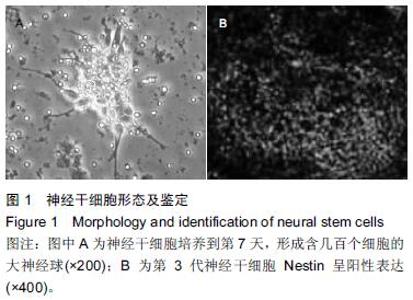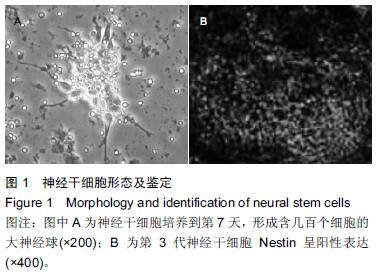Chinese Journal of Tissue Engineering Research ›› 2016, Vol. 20 ›› Issue (14): 2092-2097.doi: 10.3969/j.issn.2095-4344.2016.14.017
Previous Articles Next Articles
Neural stem cell transplantation for treatment of cerebral palsy
Lou Yuan-jun1, Liu Yang2, Shan Hai-jun1, Cao Cai-hong1, Jie Xiao-su1
- 1Second Affiliated Hospital of Henan University of Chinese Medicine, Zhengzhou 450000, Henan Province, China; 2Graduate Office, Henan University of Chinese Medicine, Zhengzhou 450000, Henan Province, China
-
Received:2016-02-14Online:2016-04-01Published:2016-04-01 -
Contact:Liu Yang, Master, Lecturer, Graduate Office, Henan University of Chinese Medicine, Zhengzhou 450000, Henan Province, China -
Supported by:the Nursery Engineering Project of Henan University of Chinese Medicine, No. MP2011-16
Cite this article
Lou Yuan-jun, Liu Yang, Shan Hai-jun, Cao Cai-hong, Jie Xiao-su. Neural stem cell transplantation for treatment of cerebral palsy[J]. Chinese Journal of Tissue Engineering Research, 2016, 20(14): 2092-2097.
share this article
| [1] 吴云.小儿脑性瘫痪的发病机制及诊治进展[J].安徽医学, 2011,32(6):859-862. [2] 罗华英.头颅CT在小儿脑瘫诊断中的作用[J].江西医药, 2009,44(3):271-272. [3] 胡春维,张斌,秋艳萍,等.脑性瘫痪198例临床分析[J].陕西医学杂志,2010,39(7):887-888. [4] 殷方明,史敏康,史丽峰.神经节苷脂治疗新生儿中重度缺氧缺血性脑病疗效观察[J].现代中西医结合杂志.2010, 19(14):1739-1740. [5] 宋令瑄.神经节苷酯辅助治疗小儿脑瘫的临床研究[J].中国实用神经疾病杂志,2009,12(17):63-64. [6] 怀智勇.小儿痉挛型脑瘫的中西医治疗概况[J].按摩与康复医学:下旬刊,2012,3(1):47-48. [7] 王艳,唐强,李晓艳,等.小儿脑瘫的康复研究进展[J].中国康复,2010,25(6):470-472. [8] 汪美君,兰金山,李胜.播放音乐对局部麻醉鼻内镜手术患者焦虑及疼痛的影响[J].护理与康复,2011,10(10):844- 845. [9] 张超,芮芳,唐久来,等.小儿脑性瘫痪影响因素与临床类型的关系[J].安徽医学,2010,31(7):719-722. [10] 张健,赵澎.小儿脑瘫的中医研究近况[J].医学综述,2010, 16(7):1092-1095. [11] 李晓捷.关注小儿脑性瘫痪中西医康复疗法的实践与研究[J]. 中国中西医结合儿科学,2010,2(1):1. [12] Zheng XR, Zhang SS, Yin F, et al. Neuroprotection of VEGF-expression neural stem cells in neonatal cerebral palsy rats. Behav Brain Res. 2012;230(1): 108-115. [13] Azari H, Rahman M, Sharififar S, et al. Isolation and expansion of the adult mouse neural stem cells using the neurosphere assay. J Vis Exp. 2010;(45). pii: 2393. [14] Deleyrolle LP, Reynolds BA. Isolation, expansion, and differentiation of adult Mammalian neural stem and progenitor cells using the neurosphere assay. Methods Mol Biol. 2009;549:91-101. [15] Azari H, Osborne GW, Yasuda T, et al. Purification of immature neuronal cells from neural stem cell progeny. PLoS One. 2011;6(6):e20941. [16] Louis SA, Mak CK, Reynolds BA. Methods to culture, differentiate, and characterize neural stem cells from the adult and embryonic mouse central nervous system. Methods Mol Biol. 2013;946:479-506. [17] Xu N, Papagiannakopoulos T, Pan G, et al. MicroRNA-145 regulates OCT4, SOX2, and KLF4 and represses pluripotency in human embryonic stem cells. Cell. 2009;137(4):647-658. [18] Yue F, Chen B, Wu D, et al. Biological properties of neural progenitor cells isolated from the hippocampus of adult cynomolgus monkeys.Chin Med J (Engl). 2006;119(2):110-116. [19] Fansa H, Keilhoff G. Comparison of different biogenic matrices seeded with cultured Schwann cells for bridging peripheral nerve defects. Neurol Res. 2004; 26(2):167-173. [20] Rosenblum S, Wang N, Smith TN, et al. Timing of intra-arterial neural stem cell transplantation after hypoxia-ischemia influences cell engraftment, survival, and differentiation. Stroke. 2012;43(6): 1624-1631. [21] Daadi MM, Davis AS, Arac A, et al. Human neural stem cell grafts modify microglial response and enhance axonal sprouting in neonatal hypoxic-ischemic brain injury. Stroke. 2010;41(3):516-523. [22] Lee JS, Hong JM, Moon GJ, et al. A long-term follow-up study of intravenous autologous mesenchymal stem cell transplantation in patients with ischemic stroke. Stem Cells. 2010;28(6):1099-1106. [23] Tan JL, Zheng XR, Zhang SS, et al.Response of the sensorimotor cortex of cerebral palsy rats receiving transplantation of vascular endothelial growth factor 165-transfected neural stem cells. Neural Regen Res. 2014;9 (19): 1763-1769. [24] Amit M, Chebath J, Margulets V, et al. Suspension culture of undifferentiated human embryonic and induced pluripotent stem cells. Stem Cell Rev. 2010; 6(2):248-259. [25] van Velthoven CT, Kavelaars A, van Bel F, et al. Nasal administration of stem cells: a promising novel route to treat neonatal ischemic brain damage. Pediatr Res. 2010;68(5):419-422. [26] 栾佐,屈素清,刘卫鹏,等.人神经干细胞移植治疗重度视觉障碍脑瘫患儿的临床观察[J].中国康复理论与实践,2007, 13(12): 1103-1105. [27] Wei L, Fraser JL, Lu ZY, et al. Transplantation of hypoxia preconditioned bone marrow mesenchymal stem cells enhances angiogenesis and neurogenesis after cerebral ischemia in rats. Neurobiol Dis. 2012; 46(3):635-645. [28] Li M, Yu A, Zhang F, et al. Treatment of one case of cerebral palsy combined with posterior visual pathway injury using autologous bone marrow mesenchymal stem cells.J Transl Med. 2012;10:100. [29] Lu D, Chen B, Liang Z, et al. Comparison of bone marrow mesenchymal stem cells with bone marrow-derived mononuclear cells for treatment of diabetic critical limb ischemia and foot ulcer: a double-blind, randomized, controlled trial. Diabetes Res Clin Pract. 2011;92(1):26-36. [30] 杜侃,栾佐,屈素清,等.骨髓间充质干细胞移植治疗小儿重度脑性瘫痪的疗效观察[J].临床儿科杂志,2011,29(1): 55-58. [31] Sun J, Allison J, McLaughlin C, et al. Differences in quality between privately and publicly banked umbilical cord blood units: a pilot study of autologous cord blood infusion in children with acquired neurologic disorders. Transfusion. 2010;50(9):1980-1987. [32] Lee YH, Choi KV, Moon JH, et al. Safety and feasibility of countering neurological impairment by intravenous administration of autologous cord blood in cerebral palsy. J Transl Med. 2012;10:58. [33] 杨华强,张荣环,杜玲,等.脐带间充质干细胞移植对脑瘫患儿运动功能的影响[J].现代生物医学进展,2012,12(2): 250-252. [34] Jensen A, Hamelmann E. First autologous cell therapy of cerebral palsy caused by hypoxic-ischemic brain damage in a child after cardiac arrest-individual treatment with cord blood. Case Rep Transplant. 2013; 2013:951827. [35] 吴景文,贾丹兵,曲超法,等.干细胞移植治疗小儿脑瘫的临床疗效:40例报告[J].中华神经外科疾病研究杂志,2011, 10(5):424-427. [36] 栾佐.新生动物及其缺血性脑损伤神经干细胞移植的研究现状[J].中华儿科杂志,2004,42(4):305-308. [37] 杨万章,吴芳,张敏,等.脐血源神经干细胞移植治疗神经系统疾病临床总结和分析[J].中西医结合心脑血管病杂志, 2009,7(3):287-290. [38] Nakamura M, Toyama Y, Okano H.Transplantation of neural stem cells for spinal cord injury.Rinsho Shinkeigaku. 2005;45(11):874-876. |
| [1] | Zhang Tongtong, Wang Zhonghua, Wen Jie, Song Yuxin, Liu Lin. Application of three-dimensional printing model in surgical resection and reconstruction of cervical tumor [J]. Chinese Journal of Tissue Engineering Research, 2021, 25(9): 1335-1339. |
| [2] | Guan Qian, Luan Zuo, Ye Dou, Yang Yinxiang, Wang Zhaoyan, Wang Qian, Yao Ruiqin. Morphological changes in human oligodendrocyte progenitor cells during passage [J]. Chinese Journal of Tissue Engineering Research, 2021, 25(7): 1045-1049. |
| [3] | Zeng Yanhua, Hao Yanlei. In vitro culture and purification of Schwann cells: a systematic review [J]. Chinese Journal of Tissue Engineering Research, 2021, 25(7): 1135-1141. |
| [4] | Xu Dongzi, Zhang Ting, Ouyang Zhaolian. The global competitive situation of cardiac tissue engineering based on patent analysis [J]. Chinese Journal of Tissue Engineering Research, 2021, 25(5): 807-812. |
| [5] | Wu Zijian, Hu Zhaoduan, Xie Youqiong, Wang Feng, Li Jia, Li Bocun, Cai Guowei, Peng Rui. Three-dimensional printing technology and bone tissue engineering research: literature metrology and visual analysis of research hotspots [J]. Chinese Journal of Tissue Engineering Research, 2021, 25(4): 564-569. |
| [6] | Chang Wenliao, Zhao Jie, Sun Xiaoliang, Wang Kun, Wu Guofeng, Zhou Jian, Li Shuxiang, Sun Han. Material selection, theoretical design and biomimetic function of artificial periosteum [J]. Chinese Journal of Tissue Engineering Research, 2021, 25(4): 600-606. |
| [7] | Liu Fei, Cui Yutao, Liu He. Advantages and problems of local antibiotic delivery system in the treatment of osteomyelitis [J]. Chinese Journal of Tissue Engineering Research, 2021, 25(4): 614-620. |
| [8] | Li Xiaozhuang, Duan Hao, Wang Weizhou, Tang Zhihong, Wang Yanghao, He Fei. Application of bone tissue engineering materials in the treatment of bone defect diseases in vivo [J]. Chinese Journal of Tissue Engineering Research, 2021, 25(4): 626-631. |
| [9] | Zhang Zhenkun, Li Zhe, Li Ya, Wang Yingying, Wang Yaping, Zhou Xinkui, Ma Shanshan, Guan Fangxia. Application of alginate based hydrogels/dressings in wound healing: sustained, dynamic and sequential release [J]. Chinese Journal of Tissue Engineering Research, 2021, 25(4): 638-643. |
| [10] | Chen Jiana, Qiu Yanling, Nie Minhai, Liu Xuqian. Tissue engineering scaffolds in repairing oral and maxillofacial soft tissue defects [J]. Chinese Journal of Tissue Engineering Research, 2021, 25(4): 644-650. |
| [11] | Xing Hao, Zhang Yonghong, Wang Dong. Advantages and disadvantages of repairing large-segment bone defect [J]. Chinese Journal of Tissue Engineering Research, 2021, 25(3): 426-430. |
| [12] | Chen Siqi, Xian Debin, Xu Rongsheng, Qin Zhongjie, Zhang Lei, Xia Delin. Effects of bone marrow mesenchymal stem cells and human umbilical vein endothelial cells combined with hydroxyapatite-tricalcium phosphate scaffolds on early angiogenesis in skull defect repair in rats [J]. Chinese Journal of Tissue Engineering Research, 2021, 25(22): 3458-3465. |
| [13] | Wang Hao, Chen Mingxue, Li Junkang, Luo Xujiang, Peng Liqing, Li Huo, Huang Bo, Tian Guangzhao, Liu Shuyun, Sui Xiang, Huang Jingxiang, Guo Quanyi, Lu Xiaobo. Decellularized porcine skin matrix for tissue-engineered meniscus scaffold [J]. Chinese Journal of Tissue Engineering Research, 2021, 25(22): 3473-3478. |
| [14] | Mo Jianling, He Shaoru, Feng Bowen, Jian Minqiao, Zhang Xiaohui, Liu Caisheng, Liang Yijing, Liu Yumei, Chen Liang, Zhou Haiyu, Liu Yanhui. Forming prevascularized cell sheets and the expression of angiogenesis-related factors [J]. Chinese Journal of Tissue Engineering Research, 2021, 25(22): 3479-3486. |
| [15] | Liu Chang, Li Datong, Liu Yuan, Kong Lingbo, Guo Rui, Yang Lixue, Hao Dingjun, He Baorong. Poor efficacy after vertebral augmentation surgery of acute symptomatic thoracolumbar osteoporotic compression fracture: relationship with bone cement, bone mineral density, and adjacent fractures [J]. Chinese Journal of Tissue Engineering Research, 2021, 25(22): 3510-3516. |
| Viewed | ||||||
|
Full text |
|
|||||
|
Abstract |
|
|||||



